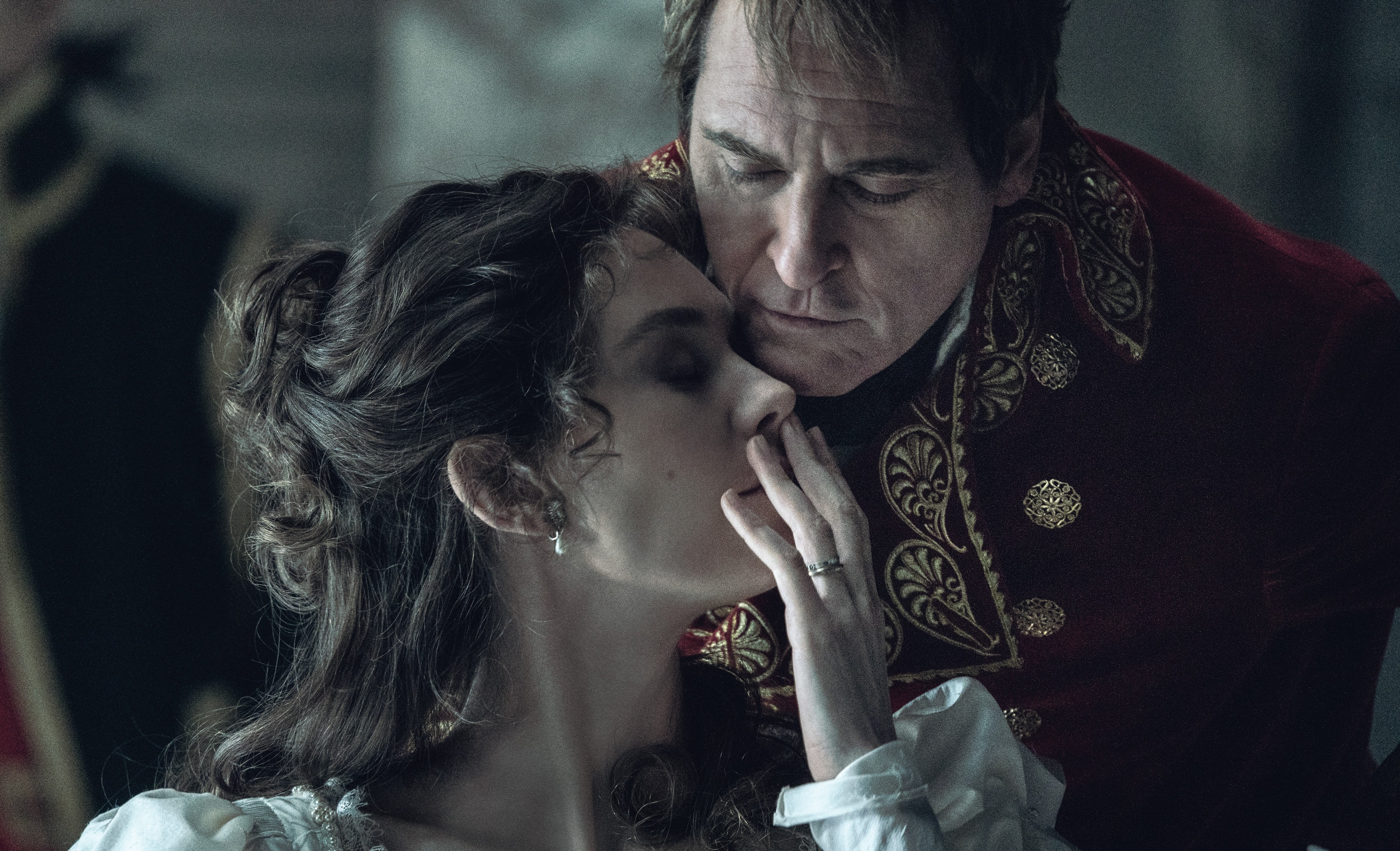
Napoleon: The Intimate and the Epic
Dariusz Wolski, ASC and director Ridley Scott work at a quick pace with multiple cameras to frame nuanced character work and grand battlefields.
All images courtesy of Apple Original Films
Napoleon Bonaparte, in life, was the bane of European aristocrats, transforming France into a 19th-century military juggernaut and bringing the Western world to its knees. In death, he has challenged some of the most accomplished filmmakers, eluding their attempts to fully capture his story onscreen. Abel Gance envisioned telling the tale across six motion-picture epics, yet only managed one, Napoléon (1927). In the wake of the success of 2001: A Space Odyssey (AC June ’68), Stanley Kubrick devoted years to developing a Napoleon project that never came to fruition. Such was not the case for director Ridley Scott and longtime collaborator Dariusz Wolski, ASC. With Napoleon, they tackled “le petit corporal” as his troops affectionately called him, head on.
“We shot a minimum of four cameras every day on some epic scales. There were lots of pieces of the puzzle to put together.”
— Dariusz Wolski, ASC
A Moment’s Notice
Scott is famous for the intensity and speed of his productions, and Wolski, who has collaborated with him since Prometheus (AC July ’12), is ready at a moment's notice for whatever he proposes. That includes jumping from one project to the next, as they did with The Last Duel, House of Gucci (both featured in AC Jan. ’22) and Napoleon. “We were actually finishing Gucci in Rome, and Ridley said, ‘You know, Malta is an hour away on the plane. Should we just go check it out for the next one?” Wolski recalls. “Literally the day after we wrapped Gucci, we were in Malta scouting.”
Common Grammar
Wolski says despite hailing from different countries, he and Scott share a similar understanding of cinematic grammar, which gave them “an instant shorthand.” He explains, “I was raised in Warsaw in the communist days, and I watched a lot of movies when I was very young — instead of going to school, I ’d go to old revival theaters. That was quite an education: black-and-white, Charlie Chaplin, Buster Keaton. Then I got into the English Free Cinema; European filmmakers like Bergman, Fellini, Pasolini, all the Italians; and ’70s American movies. I was really influenced by all that stuff, even Tarkovsky. It was quite beautiful, because when I eventually started working with Ridley, we realized we grew up with the same terms.”
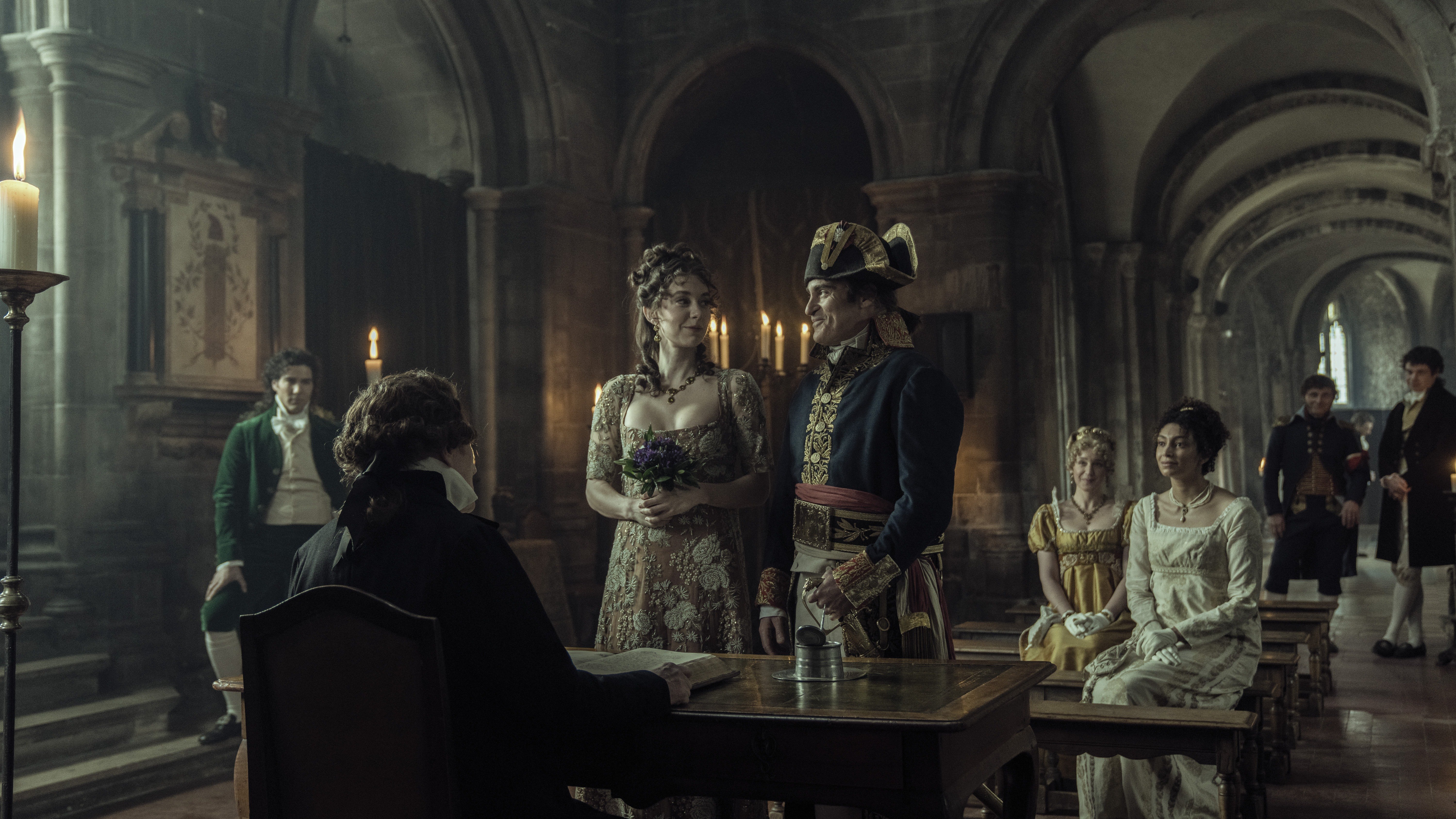
One of the films Wolski and Scott discussed in prep for Napoleon was Gance’s silent epic, which Wolski happened to see onscreen at Radio City Music Hall in 1981, a year after he arrived in the United States. “Francis Ford Coppola’s father [Carmine] was conducting the music because Francis was responsible for restoring it and re-releasing it,” Wolski says. “Abel Gance was still alive, and I remember there was a standing ovation. Francis brought the phone on the stage and faced the audience so that Abel Gance, 91 and in France, could hear the applause.”
The only film Scott and Wolski watched in prep was Scott ’s debut feature, The Duellists (shot by Frank Tidy, BSC). “We watched it a few times,” says Wolski. “It’s set in Napoleonic times, but much smaller in scale. The costumes, the vibe, the feeling — everything was kind of like Napoleon, but the small version.”
Neo-classical paintings from the period were also an influence, particularly The Coronation of Napoleon by court painter Jacques-Louis David. “Our coronation scene in the film is trying to be a complete ripoff of the painting,” Wolski says with a chuckle.
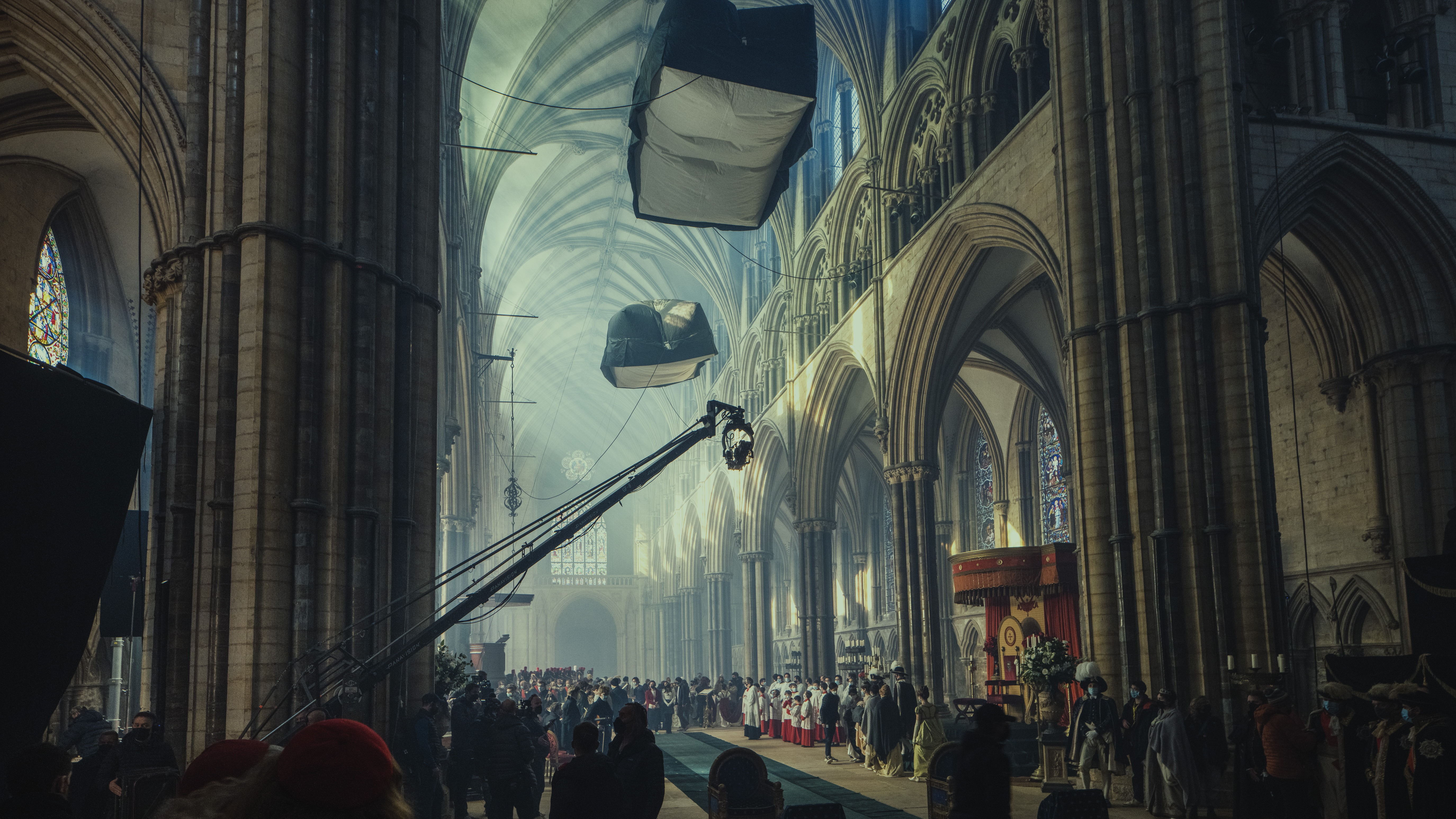
62-Day Shoot
Principal photography was completed entirely on location in 62 days. Scott’s team can work at such a pace because of the multi-camera technique he has been refining since American Gangster, shot by Harris Savides, ASC (AC Dec. ’07). Whereas traditional filmmaking calls for one or two cameras to cover a scene, Scott prefers deploying four for a dialogue scene and as many as 11 for action-oriented material.
Though the director’s methods call for the simultaneous supervision of many cameras, Wolski has embraced the strategy. He captured most scenes in Napoleon with four Arri Alexa Mini LFs.
“There’s so much conversation about lenses. I’m fine with what I have. I don’t need to experiment anymore.”

The cornerstone of the team’s previs are detailed storyboards drawn by Scott — who trained in fine art at England’s Royal College of Art — which his collaborators have dubbed “Ridleygrams.” Wolski uses the sketches to arrange the cameras in any given location. “When you have multiple cameras, you want to be able to put them in the right place,” the cinematographer says. “And sometimes it’s a question of inches — one camera’s a little bit tighter, a little wider just to accommodate the whole setup in a space so that the cameras don’t see each other.”
Shaping the Space
The multi-camera system is designed not only for production speed, but also to protect the actors’ performances — and when fine-tuning camera placement, the latter is Wolski’s main objective. “It’s always to create a space for actors to do their thing,” he says. “There has to be an atmosphere to it.”
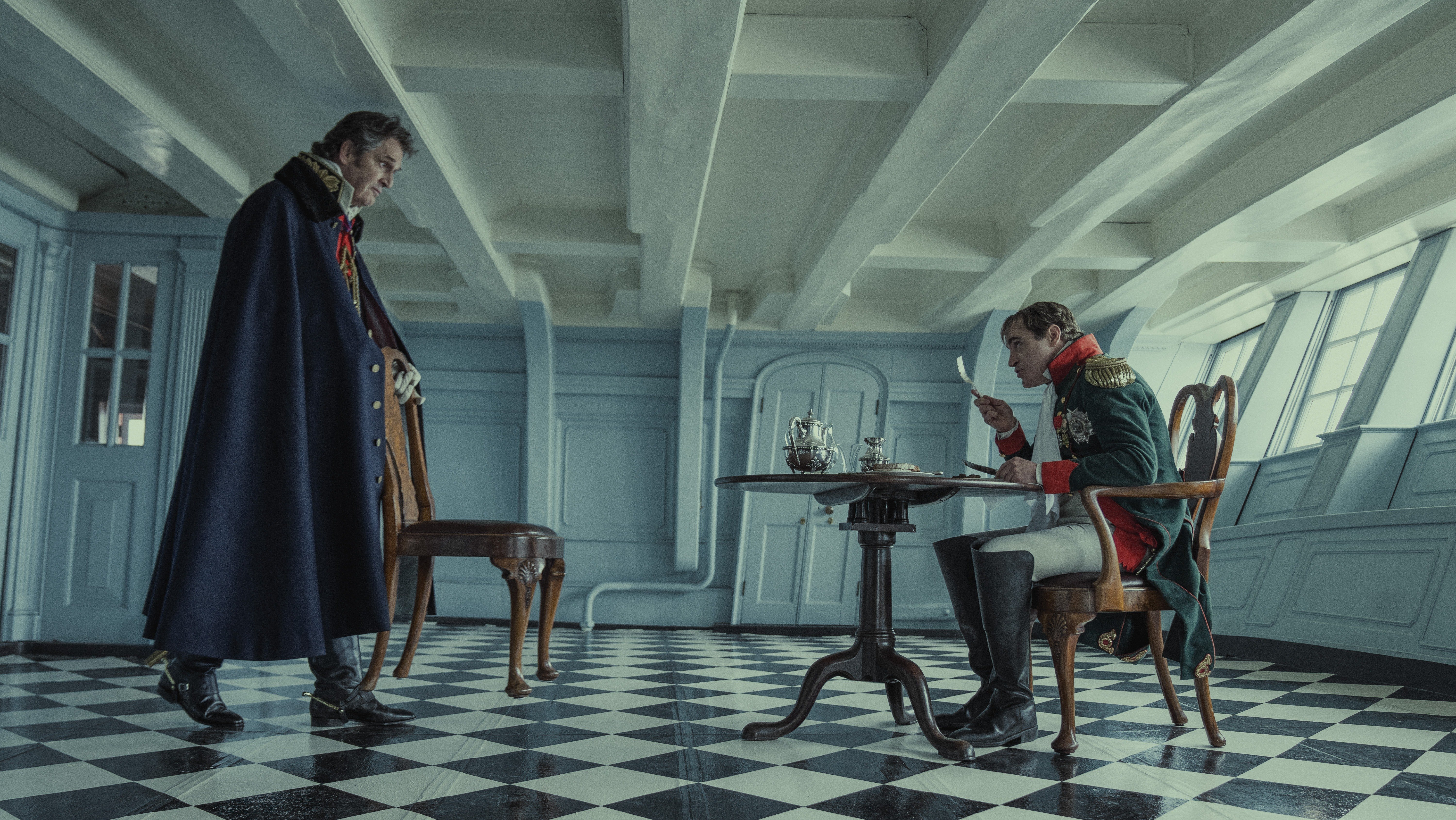
Wolski shapes that atmosphere through lighting, which, to him, is just another element in the space. “If it’s the palace, then you just use windows or candles, but you try to be true to the source. Because Ridley likes to use multiple cameras, you basically light the space and let actors just move within it. We have this way of staging scenes that can be very dramatic. Because you have different points of view of this space from multiple cameras, an actor can move from one place to another and it creates a completely open canvas to see what happens. There’s no formula. If you have a big window with light coming through, if the actor looks sideways, you’re going to have a beautiful half-light, and if the actor looks away from the window, they’re going to be in silhouette.”
Key grip Dutch Holland notes, “Ridley likes to move very fast and therefore is not a fan of over-complicated rigs or even camera moves. Dariusz lights extremely efficiently and often in 360 degrees. We had to have all the bases covered and the ability to change things quickly without too much fuss. We had to be extremely well-organized and efficient as a crew to keep the pace, but still try to be slick, safe and professional.”
Holland adds that the production “had a 45-foot [ServiceVision] Scorpio and a Viper all-wheel-drive articulated base with a Libra head. The Viper has leveling jacks and a leveling column. It was built for Panavision London by Bickers Action; it literally goes anywhere and takes up to a 50-foot crane on a very small footprint. [The Scorpio and Viper were] used regularly on our exterior locations. We would use smaller modular [Grip Factory] GF-Jib or smaller Scorpios for our interior locations.”
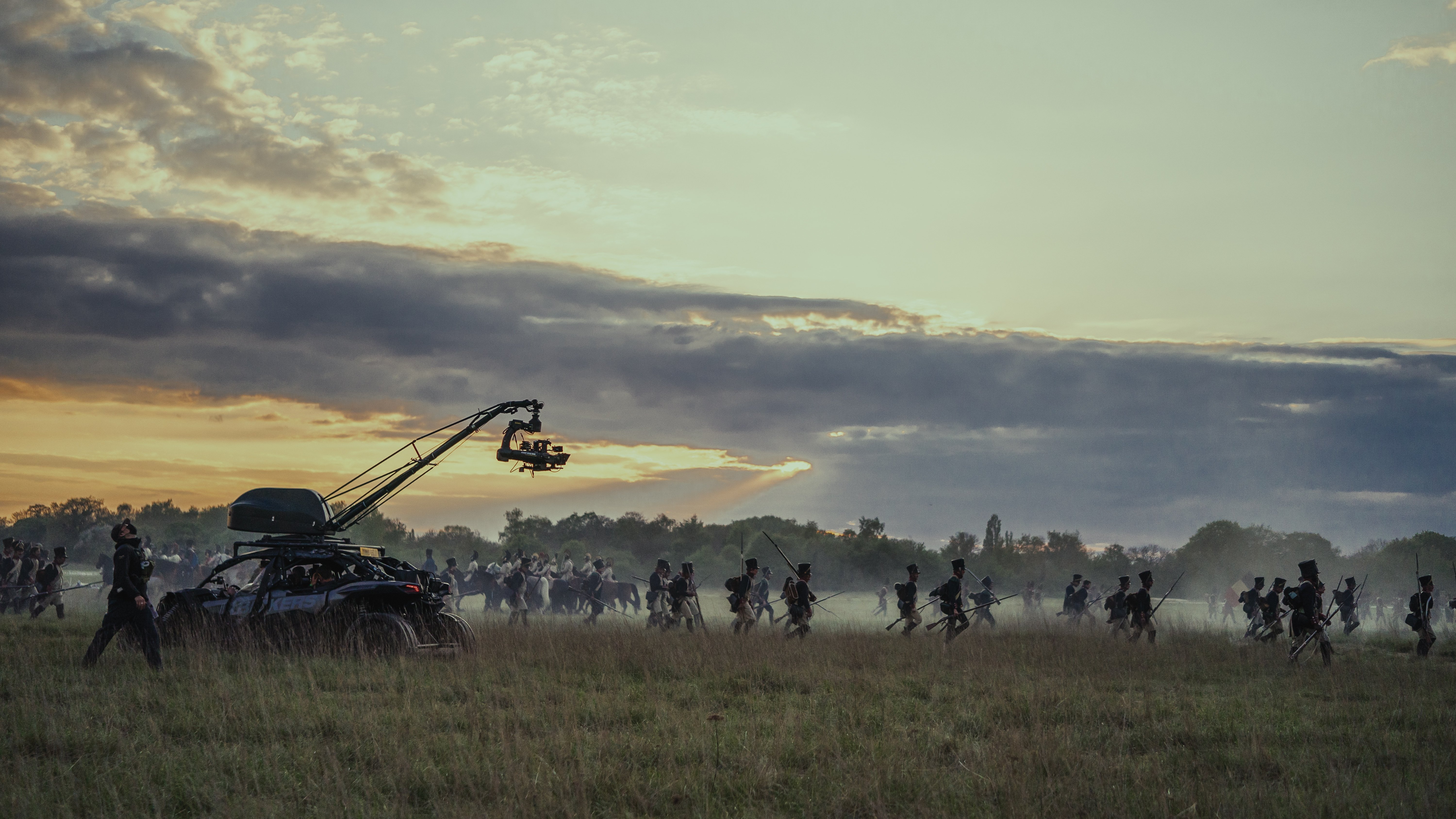
Low-Light Champions
A major challenge on this production was that many interiors were low light, illuminated solely by candles. Says Wolski, “For candlelight and especially dark interiors and exteriors, I used Panavision 65 Vintage primes. [ASC associate member] Dan Sasaki [of Panavision] built three sets for me a few years ago, and I use them all the time; I used them on The Last Duel and House of Gucci, and on News of the World with Paul Greengrass [AC March ’21]. When you really have to go low-light, with those lenses you just can go anywhere. None of them are super sharp. None have edges or anything special — they’re just nice lenses.
“There’s so much conversation about lenses. I’m fine with what I have,” he adds. “I don’t need to experiment anymore.”
Throughout the production, Scott and Wolski also relied quite a bit on zoom lenses for quick and proper framing, especially when four or five camera crews might be operating in the same space at once.
“In the whole film, 50 percent is real candlelight and 50 percent isn’t.”

LED “Candles”
Many locations prohibited the use of real candles. “We were shooting in serious English estates, and I was slowly finding out that we couldn’t use candles in some places, but could in others — it was an open discussion all the time,” Wolski says. “And I understand, because the walls had 18th-century paintings worth way more than Julian Schnabel and Damien Hirst!”
To solve the problem, Wolski’s electrical crew simulated candles with tiny, dimmer-controlled flexible LED filaments that could flicker. Wolski shot tests of the real and simulated candles next to each other, assessing how they flickered on the human face. “In the whole film, 50 percent is real candlelight and 50 percent isn’t,” he says. “Any time I was very close to actors, I tried to keep the real candles close, because that’s the hardest light to fake. But a lot of the background chandeliers and candelabras in those huge spaces had to be fake. The electrical department spent days and days basically wiring those little fake candles for some of the chandeliers. It was quite a job. Then Charley Henley, our VFX supervisor, had to put flames on top of them in post.
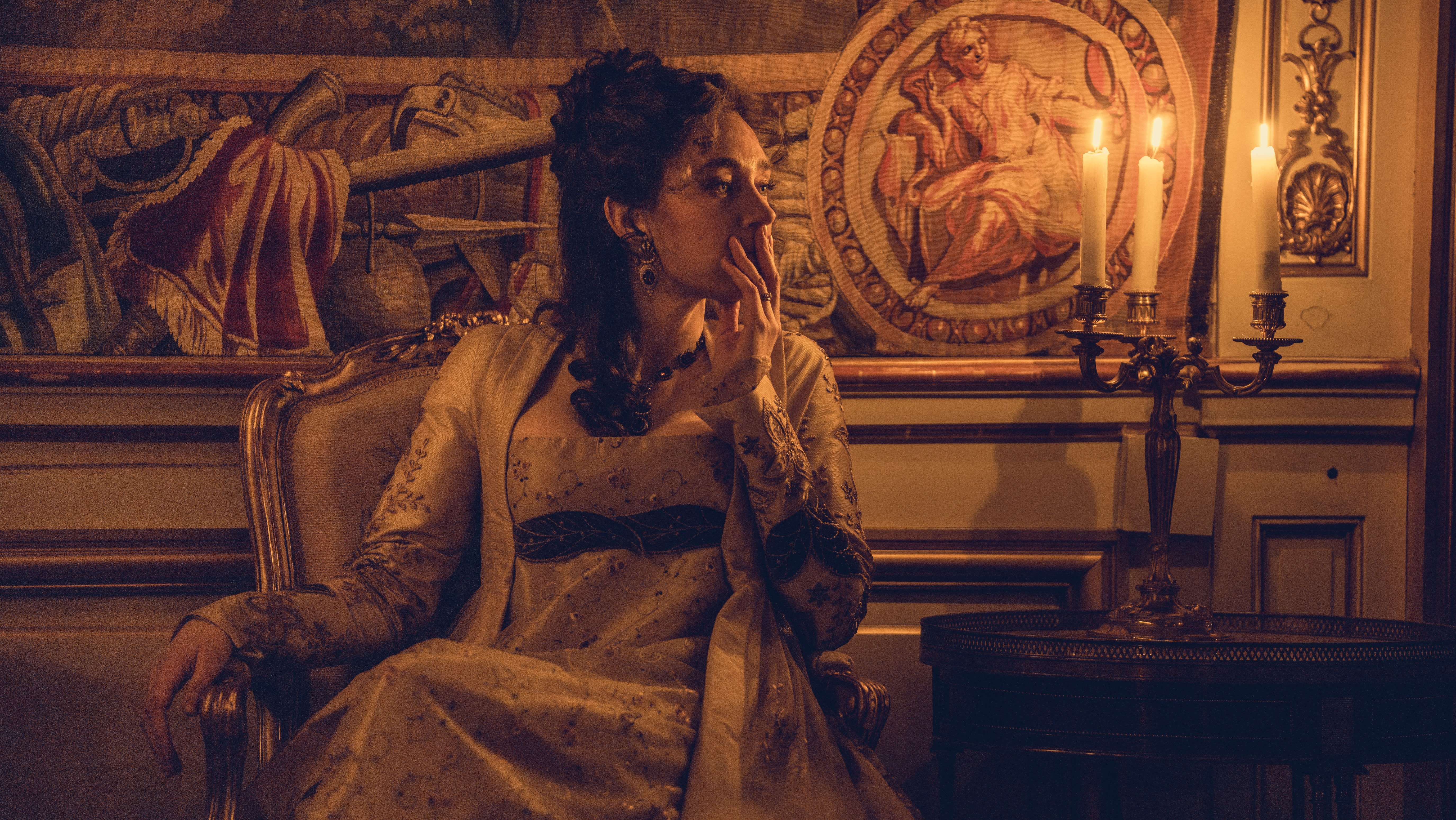
Large-Scale Battles
Re-creating some of Napoleon’s legendary battles was a Herculean task, given the scope Scott desired. Some sequences required massive outdoor sets and bluescreens, and some called for hundreds of horses and soldiers gathered in square formations.
Production designer Arthur Max made geological surveys of the selected battle locations and used them to create 8'x8' miniature landscape maps complete with model forests and villages. Scott and Wolski arranged toy-soldier units to determine how to cover the action. A historical adviser, Lorris Chevalier, was on hand to ensure accuracy.
“You strategize first with a map and the landscape model, then you strategize before you shoot and set things up,” Wolski says. “It seems like a lot of stages of preparedness, but when you roll, you’re just rolling.

“You create an event and then try to capture it,” he adds. “It’s a little bit like shooting a rock concert. The horses can only run so much for so long, and if you run horses full speed over such a huge distance, after three or four takes they’re exhausted. Ridley loves horses, so he puts [in] as many cameras as he can, knowing it’s going to last two hours and be over. So, if you don’t catch it, good luck!”
Wolski often ran 11 cameras simultaneously for these scenes. Some were fitted to gyro-stabilized Filmotechnic Flight Heads on U-Cranes, Holland explains, “either on a [Ford] Raptor base or a [Mercedes] ML63 AMG, or we used a U-Crane Mini on a Polaris. Sometimes we used all three! Ground cameras were on Steadicam, sliders and dollies — and sometimes on crash boxes or just on a steady bag on the floor.
“[Gaffer] Jonathan Spencer and I stuck to Dariusz and Ridley’s sides all day, every day to make sure we heard the information first — either on the set or in the video/DIT trailer,” Holland continues. “We were always with them. There was a lot of information flowing, and [1st AD] Ray Kirk had a brilliant handle on the sharing of that information, and on the crew."
Seizing a Port
The siege of the French port city of Toulon, during which Napoleon leads the charge to capture a fort from the British, depended on a combination of day and night sets with bluescreens. Fort Ricasoli in Malta doubled as Toulon, because much of Maltese architecture is built from sandstone and resembles the look of southern France during the Napoleonic period. (Other locations in Malta were used to shoot interiors, the final scene in St. Helena, parts of Napoleon’s time in Elba, and some scenes in the Paris streets.)
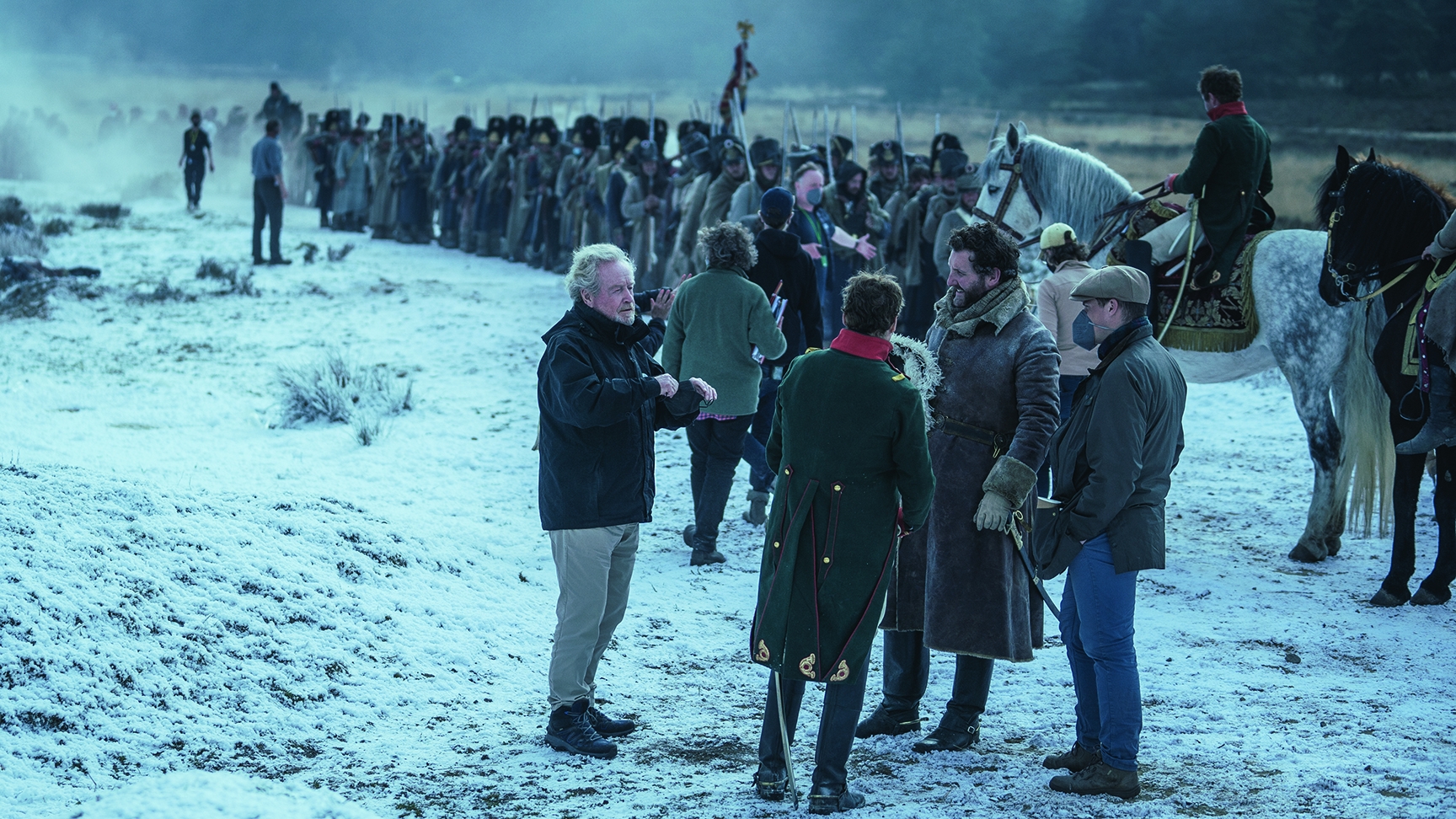
The battle had to be broken down into three components. “The fort was only 10-feet-by-10-feet deep out there, and there was a big cliff, so we could only shoot the battle from below,” Wolski says. “Once the soldiers get on top of the fort, there was an elevated set. We actually built it in exactly the same space that Ridley built the Coliseum for Gladiator [AC May ’00]. Where the soldiers fire the cannons and where they look down, we had to put a bluescreen and then shoot the plates, the sea explosions and all that stuff.”
The bluescreens were rigged via “40-foot shipping containers on trailers, with 20-by-20s and skirts, making them about 30 feet high,” Holland says. “We also used some local telescopic handlers and truss frames as mobiles.”
Victory on Ice
The Battle of Austerlitz had two sets. The first was a woodland area in Farnham, in the Surrey Hills, U.K. — the same location where Scott shot the opening battle scene of Gladiator. In the scene, an incognito Napoleon scopes out the forest where he and his troops later camp. The second site was a vast, snowed-in English airport that doubled for the frozen lake in what is now the Czech Republic. Wolski explains that these two sets were sometimes composited together — for example, in a sequence where Napoleon looks out at the enemy camp. For this setup, Phoenix was filmed in the actual forest, while the “huge, wide shots of this other set were basically his POV,” the cinematographer says. “So, when you look over his shoulder toward the enemy camp, the foreground of the shot is in the forest, and everything else is an extension [incorporating footage from] the other set that we shot at the airport.
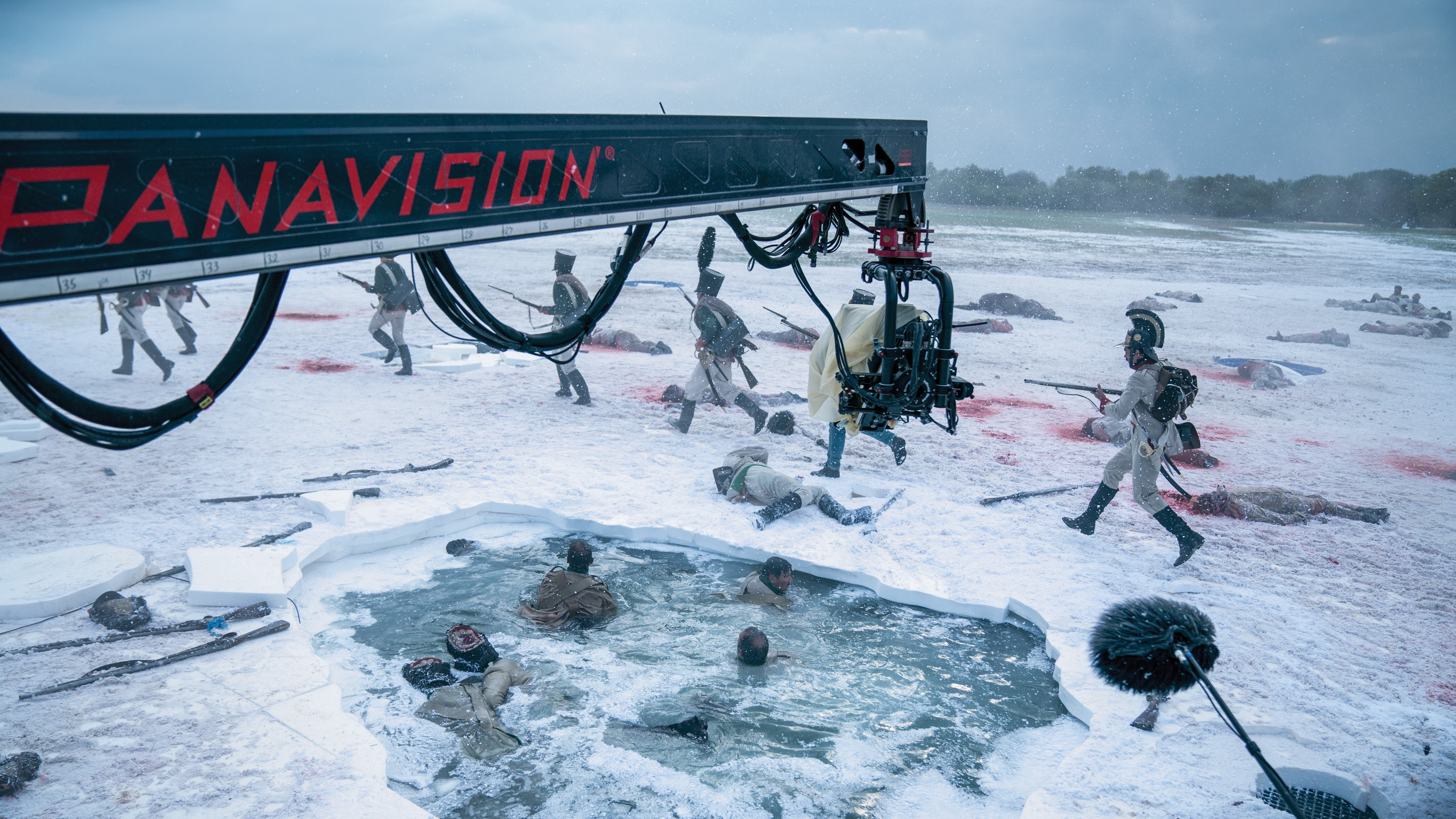
Wolski adds that the snowy airport set was dotted with swimming pool-like “gaps” — ranging from approximately 6'x6' to 20'x20' — where surfaces of “fake ice” were placed. “Eventually, the cavalry [comes in for] the attack, and you see them falling at the beginning in a wide shot. The 2nd unit filmed all the soldiers falling on their knees and closer stuff.” The latter material was shot by Daniele Massaccesi, AIC, who also served as the film’s A-camera operator.

Last Conflict
During the Battle of Waterloo, where Napoleon was finally defeated, the French and opposing forces were camped a mile apart. Wolski and Scott maintained that actual distance in their staging of the action. “When we shot everything on the French side, we always left one or two cameras on the English side, so we could shoot whatever was happening out here from over there, even though there was a mile of distance,” says Wolski. “It was two completely separate groups with radio transmitters. Sometimes we used to forget about them and then discover — ‘Oh, there’s a long lens!’”
Heavy-lift drones and DJI Inspires — the former carrying Mini LFs — recorded the warring parties from above.
First AC Alberto “Niño” Torrecilla notes that the Mini LFs were needed for aerial battlefield shots that would require CG work. “Higher resolution was requested,” he recalls, “and I remember quite well requesting more lenses, like Zeiss CP.3s, that we could ‘sacrifice’ in the worst-case scenario. There was no way we could fly those vintage lenses — definitely not expendable.” He adds that the Mini LFs were also used for drone shots that required slow-motion work.
To capture close-ups during the Waterloo sequence, select stunt performers in uniform held boom poles rigged with DJI Zenmuse cameras on small XM2 remote heads as they rushed into “combat,” joining square formations of soldiers. “The squares were three in a row, and a real square was actually 600 men,” Wolski notes. “Ours were smaller, like 200 or 300, but they still looked pretty impressive. In the real battle, there were probably 10 squares. In our film, the other squares were digitally replicated for the big wide shots. But once you go into battle, you only see one square because the action happens around one square at a time.
Extensive Optics
“Ridley loves zooms — he loves the idea that he can adjust the size even during the shot,” Torrecilla says. “He loves finding the right frame through a zoom lens without wasting time changing lenses. He will always use zooms until there’s a need for a fast prime or wider prime.
“We carried two Panavision Primo Plus 11:1 35-400mm zooms and one Panavision Primo LF 11:1 40-470mm, as well as a bunch of Angénieux EZs — [approximately] five EZ-1s and five EZ-2s,” he adds, the latter of which suited tight interiors and enabled handheld and Steadicam work. “There was also a modified Nikon 300mm Nikkor T2 telephoto lens with a Panavision 65 mount in the back. Then, during the weeks of battles — including Waterloo and the Russian campaign — we added more Panavision Primo 3:1 zooms with doublers to the package, along with another Panavision Primo LF 11:1 zoom and another couple of those EZs.
“You’re never going to have so many horses, so many amazing horsemen, so many great actors, so many incredible costumes, so many incredible sets. Ridley has a hard time beating himself, but for me, this film’s right up there.”
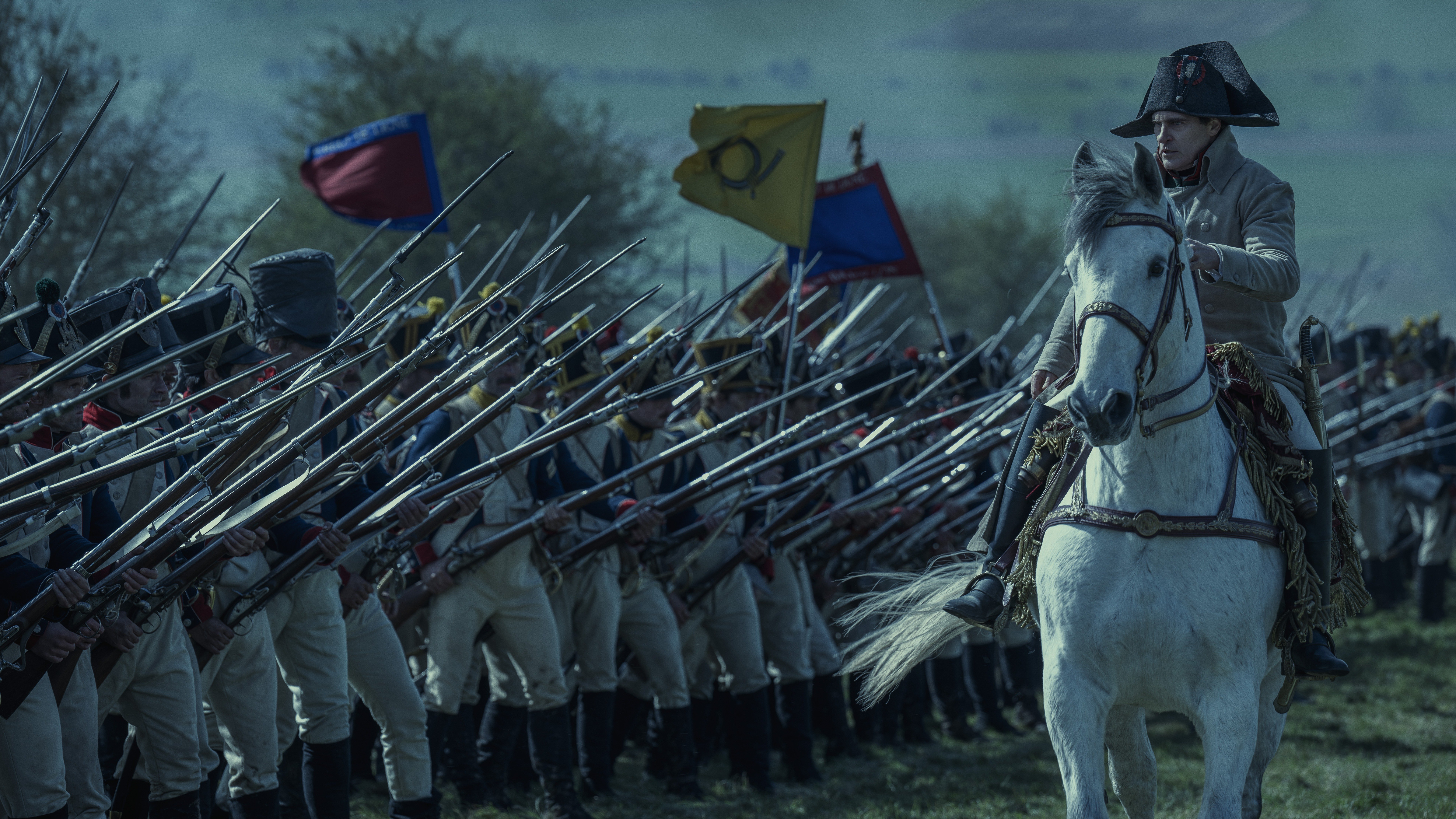
Torrecilla is a fan of the spherical Panavision prime lenses that Wolski has been using. “Through the years, Dan and his team have improved every single one of those lenses,” he says. “On The Last Duel, Dan built a super-wide 17mm 65 Vintage prime that was fast, marvelous and had no distortion, and he built another two for Napoleon. We started with the three existing sets — but during the shoot, just when we needed them, a fourth set showed up with a brand-new 17mm. And for the final, massive Toulon night-battle scene, a fifth set arrived.
“It was a blast,” Tottercilla adds of his work on the production. Noting that this was his fifth film with Wolski and Scott — including The Martian and All the Money in the World — he says his work with the crew is “like being with family by now. We had a great time. [Three films] happened in a row — The Last Duel, Gucci and Napoleon — but I think we really went ballistic on this last one.”
Live Grading on Set
As Scott watched the action unfold from video village, he was constantly fine-tuning the image. “Ridley always wants to see the live image as close to the final image as possible, so we’re doing on-set live grading on every scene, on every camera,” says DIT Ryan Nguyen. Nguyen applied a slightly modified Rec 709 LUT provided by Company 3 to the footage as a baseline to grade in real time. “I was using Pomfort Livegrade to control my IS-Mini LUT boxes,” Nguyen adds. “On each cart, I always carried at least 12 LUT boxes because of the number of cameras we were using.”
Scott and Wolski played extensively with color during the shoot. “They like to push everything to the edge — they don’t seem to like anything that looks too ‘normal,’” Nguyen says. “Every part of the story has a different look. This was all previewed on set and done through a combination of in-camera settings and color grading. If it’s an exterior, Dariusz likes to see what nature gives us that day, and then we adapt and create the most interesting look possible while trying to keep it natural.”
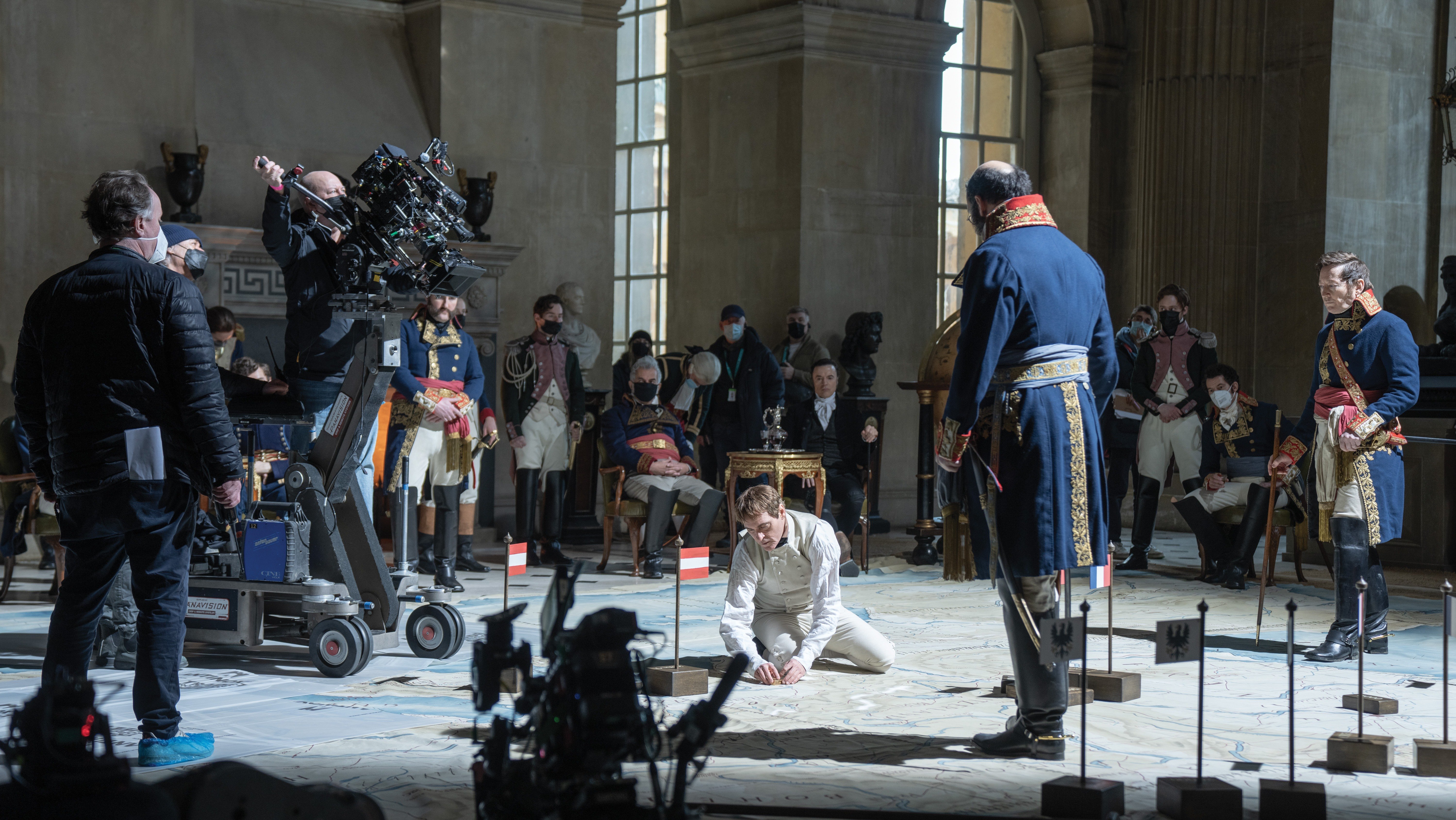
For battle sequences, while Wolski was on the battlefield determining camera placement, Nguyen was stationed with Scott in video village. “Ridley wants to know what’s happening on set at all times,” the DIT says. “By the time Dariusz returned to the village, I hopefully would have done my best to make sure everything was dialed in as close as possible for him to look at and start fine-tuning the image.
Nguyen adds that he considers himself lucky to have Scott and Wolski “involve me so much in their process. No matter how many cameras or how much of a challenge Ridley creates for Dariusz, he knows that Dariusz will somehow figure out the puzzle. On the rare occasion he can’t solve it, they patiently work together to find the solution.”
“Everything Is Intuition”
Whether it’s color or camera angles, Wolski attributes his choices to instinct. “Some people can talk about their work and explain it,” he says. “I can’t. There’s a lot of homework, a lot of research, a lot of trying to understand the period, trying to understand the characters. After that, you just capture it. Everything is intuition.”
Shooting Napoleon was an undertaking worthy of its subject, he adds. “It was huge — I mean huge. Absolutely phenomenal. You’re never going to have so many horses, so many amazing horsemen, so many great actors, so many incredible costumes, so many incredible sets. Ridley has a hard time beating himself, but for me, this film’s right up there.”
You'll find our interview with director Ridley Scott about the film here. Our complete story on the visual effects can be found here.
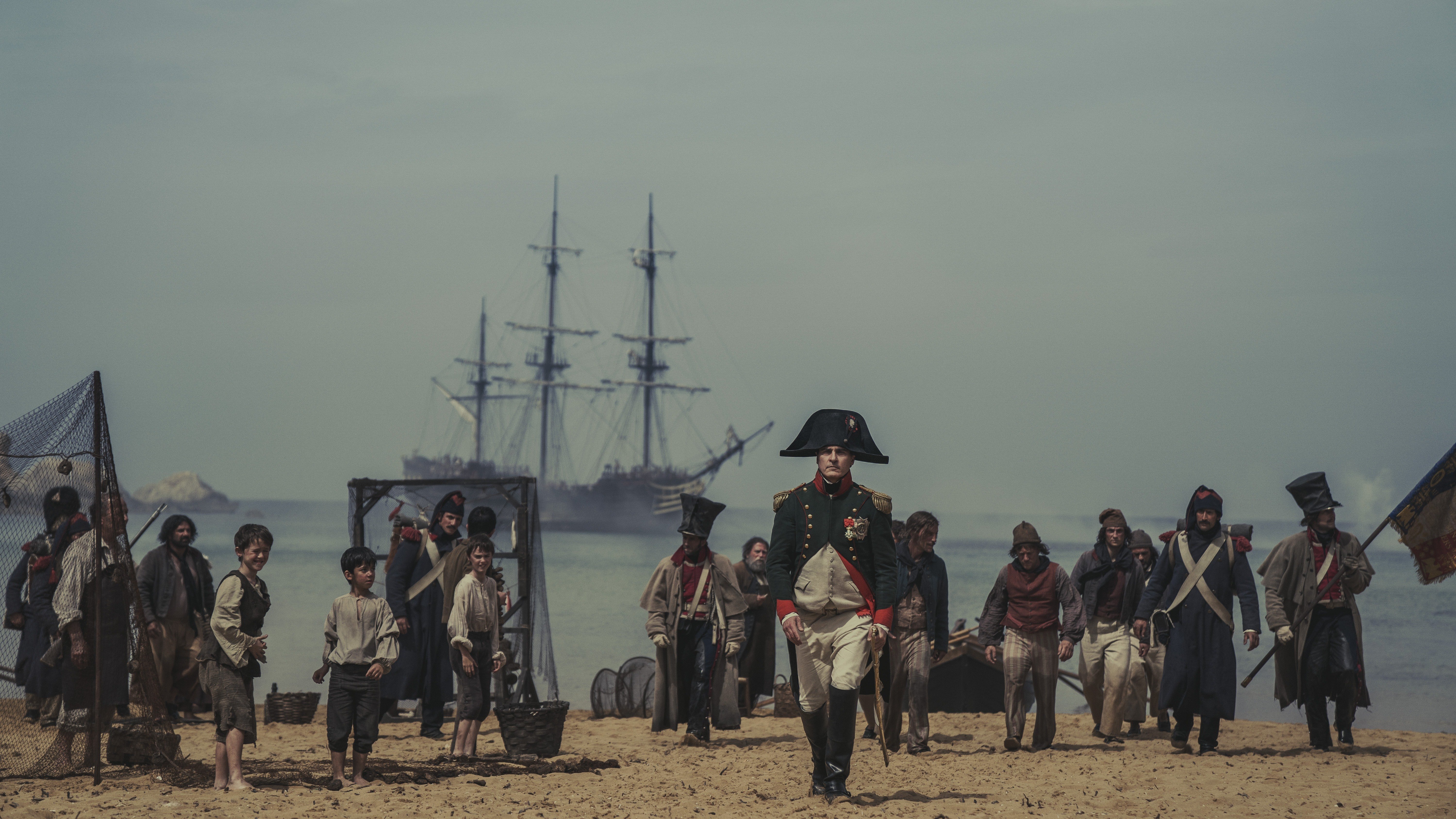
Tech Specs
2.39:1
Cameras | Arri Alexa Mini LF, DJI Zenmuse
Lenses | Angénieux EZ; Panavision 65 Vintage, Primo Zoom Plus, Primo Zoom LF, Primo Zoom; Nikon telephoto; Zeiss CP.3






